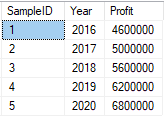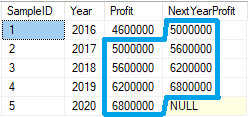SQL Server LEAD() Function
This blog is going to illustrate the functionality of SQL LEAD() and how to use it.
The SQL LEAD () function gives the next row of data for the offset value. This functionality was introduced in SQL Server 2012. Let’s see how to use it.
The following is the SampleTable.
The following query illustrates how to use the LEAD() function.
The following image is the output of the query above. Here you will find the column NextYearProfit. This shows the next profit.
In the previous example, you can see that the last NextYearProfit column value is null. You can set the default value instead of zero if you want.
In the image below you can see that the last NextYearProfit value is ‘7000000’ instead of null
Also, you can get the OFFSET value 2. That is next year’s next year value.
In the picture, the profit of 2018 appears in 2016, the profit of 2019 appears in 2017, and so on.
PARTITION BY
You can use the LEAD() function using the PARTITION BY clause.
In the image below you can see the result partition by the year.
I hope this article helps you. Keep Coding









Comments
Post a Comment